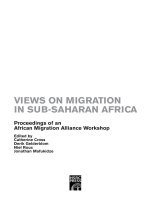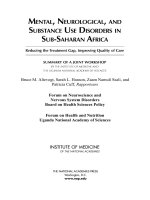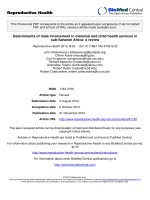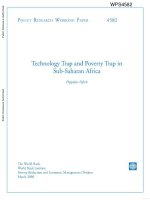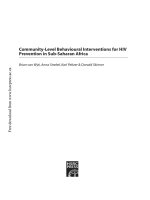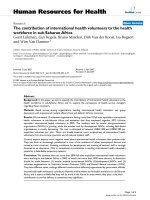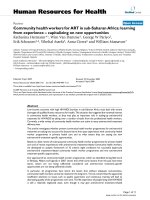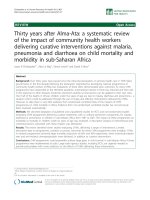Getting textbooks to every child in sub saharan africa
Bạn đang xem bản rút gọn của tài liệu. Xem và tải ngay bản đầy đủ của tài liệu tại đây (1.63 MB, 127 trang )
DIREC TIONS IN DE VELOPMENT
Human Development
Getting Textbooks to Every Child in
Sub-Saharan Africa
Strategies for Addressing the High Cost and
Low Availability Problem
Birger Fredriksen and Sukhdeep Brar
with Michael Trucano
Getting Textbooks to Every Child
in Sub-Saharan Africa
Direc tions in De velopment
Human Development
Getting Textbooks to Every Child
in Sub-Saharan Africa
Strategies for Addressing the High Cost and
Low Availability Problem
Birger Fredriksen and Sukhdeep Brar
with Michael Trucano
© 2015 International Bank for Reconstruction and Development / The World Bank
1818 H Street NW, Washington, DC 20433
Telephone: 202-473-1000; Internet: www.worldbank.org
Some rights reserved
1 2 3 4 18 17 16 15
This work is a product of the staff of The World Bank with external contributions. The findings, interpretations, and conclusions expressed in this work do not necessarily reflect the views of The World Bank, its
Board of Executive Directors, or the governments they represent. The World Bank does not guarantee the
accuracy of the data included in this work. The boundaries, colors, denominations, and other information
shown on any map in this work do not imply any judgment on the part of The World Bank concerning the
legal status of any territory or the endorsement or acceptance of such boundaries.
Nothing herein shall constitute or be considered to be a limitation upon or waiver of the privileges and
immunities of The World Bank, all of which are specifically reserved.
Rights and Permissions
This work is available under the Creative Commons Attribution 3.0 IGO license (CC BY 3.0 IGO) http://
creativecommons.org/licenses/by/3.0/igo. Under the Creative Commons Attribution license, you are free to
copy, distribute, transmit, and adapt this work, including for commercial purposes, under the following
conditions:
Attribution—Please cite the work as follows: Fredriksen, Birger, and Sukhdeep Brar, with Michael Trucano.
2015. Getting Textbooks to Every Child in Sub-Saharan Africa: Strategies for Addressing the High Cost
and Low Availability Problem. Directions in Development. Washington, DC: World Bank.
doi: 10.1596/978-1-4648-0540-0. License: Creative Commons Attribution CC BY 3.0 IGO
Translations—If you create a translation of this work, please add the following disclaimer along with the
attribution: This translation was not created by The World Bank and should not be considered an official
World Bank translation. The World Bank shall not be liable for any content or error in this translation.
Adaptations—If you create an adaptation of this work, please add the following disclaimer along with the
attribution: This is an adaptation of an original work by The World Bank. Views and opinions expressed in
the adaptation are the sole responsibility of the author or authors of the adaptation and are not endorsed by
The World Bank.
Third-party content—The World Bank does not necessarily own each component of the content
contained within the work. The World Bank therefore does not warrant that the use of any
third-party-owned individual component or part contained in the work will not infringe on the rights
of those third parties. The risk of claims resulting from such infringement rests solely with you. If you
wish to re-use a component of the work, it is your responsibility to determine whether permission is
needed for that re-use and to obtain permission from the copyright owner. Examples of components
can include, but are not limited to, tables, figures, or images.
All queries on rights and licenses should be addressed to the Publishing and Knowledge Division, The
World Bank, 1818 H Street NW, Washington, DC 20433, USA; fax: 202-522-2625; e-mail: pubrights@
worldbank.org.
ISBN (paper): 978-1-4648-0540-0
ISBN (electronic): 978-1-4648-0541-7
DOI: 10.1596/978-1-4648-0540-0
Cover photo: © Peter Darvas. Used with the permission of Peter Darvas. Further permission required for
reuse.
Library of Congress Cataloging-in-Publication Data has been requested.
Getting Textbooks to Every Child in Sub-Saharan Africa • />
Contents
Forewordix
Acknowledgmentsxi
About the Authors
xiii
Abbreviationsxv
Executive Summary
1
Objective of the Study
1
Main Findings
2
Notes8
References8
Chapter 1
Introduction and Rationale for This Study
9
Notes12
References13
Chapter 2
The State of Textbook Provision in Sub-Saharan Africa
15
Note17
References17
Chapter 3
Factors Contributing to Textbook Scarcity
19
Note20
Reference20
Chapter 4
The Urgency of Addressing the Textbook Shortage in
Sub-Saharan Africa
21
Notes26
References26
Chapter 5
Factors Determining Textbook Costs
Unit Textbook Costs
Annualized per-Student Textbook Costs
Actual Unit and Annualized Textbook Costs in SSA
Interventions and Scope for Reducing Textbook Costs
29
31
44
46
48
Getting Textbooks to Every Child in Sub-Saharan Africa •
v
vi
Contents
Notes50
References51
Chapter 6
Textbook Financing
53
Issues53
Sources and Methods of Textbook Funding in SSA
54
Government Textbook Funding in SSA
56
Estimated Share of Primary Education Budget Needed
for Adequate Supply of Textbooks
60
Estimated Share of Secondary Education Budget
65
Needed for Adequate Supply of Textbooks
Impact of External Aid
71
Notes73
References74
Chapter 7
Lessons for Sub-Saharan Africa from Countries in
Other Regions
77
India77
The Philippines
79
Vietnam81
Summary83
Notes84
References84
Chapter 8
Digital Teaching and Learning Materials:
85
Opportunities, Options, and Issues
Predictions about the Demise of Printed Textbooks
85
Educational Materials and Electronic Devices: Promise
and Potential
85
86
Some Common Myths and Misconceptions
Costs88
One Way to Begin: Targeting Different Age Groups or
91
School Subjects
General Trends
92
The Way Forward: Some Questions and Issues for
Consideration93
Ten Recommendations for Policymakers
97
Notes99
References100
Chapter 9
Lessons and Recommendations
101
How Can Sub-Saharan Countries Lower the
High Costs of Providing Textbooks?
102
References106
Getting Textbooks to Every Child in Sub-Saharan Africa • />
vii
Contents
Box
5.1
Evolution of Textbook Publishing in Sub-Saharan Africa
33
Percentage of Grade 6 Students Reaching SACMEQ Skill
Levels for Reading, 2007
Long Print Run Cost-Benefit Curve
22
39
Figures
4.1
5.1
Tables
2.1
5.1
5.2
5.3
5.4
5.5
5.6
6.1
6.2
6.3
6.4
6.5
6.6
6.7
6.8
6.9
6.10
Variations in Book:Pupil Ratios in Primary Education
16
Two Examples of Retail Price Cost Components of
Commercially Sold Textbooks in SSA (%)
30
Textbook Price Components for State Publishers
32
Sources of Authorship, Publishing, Manufacturing, and
Raw Materials for Grades 1, 6, 8, and 11
35
Comparative Prices for One- and Four-Year Textbook
Specifications37
Unit, System, and Annualized per-Student Costs for Grade 1,
Selected Countries
46
Average Unit Price, Number of Books, and Cost of Textbook
Set for Grade 9, 2007, Selected Countries
48
Sources of Textbook Funding
55
Share of Total Recurrent Public Education Budgets for
Primary and Secondary Education Spent on TLM,
2009 or Most Recent Year (%)
59
Estimated Share of Primary Education Budget (Recurrent and
Capital) Needed to Provide Textbooks for Different
Unit and System Costs
61
Annual Textbook Costs per Primary School Pupil for
Different Unit and System Costs (US$)
62
Share of Primary Education Budget Needed to Provide
Textbooks for Different Unit and System Costs (%)
63
Cost of Teaching and Learning Materials Other than Textbooks 64
Estimated Share of Secondary Education Budget (Recurrent
and Capital) Needed to Provide Textbooks for Different
Unit and System Costs
66
Annual Textbook Costs per Secondary School Student
for Different Unit and System Costs (US$)
67
Share of Secondary Education Budget Needed to Provide
Students with Textbooks for Different Unit and System
Costs (%)
68
Annual per-Student Book Costs and Budget Shares to Provide
Students with Textbooks for Different Unit and System
Costs in Secondary Education, Total and by Cycle
69
Getting Textbooks to Every Child in Sub-Saharan Africa •
viii
Contents
7.1
7.2
7.3
India: Cost of Textbooks per Pupil and Set of Textbooks
by Grade, 2011
The Philippines: Cost of Textbooks per Pupil per Set of
Textbooks by Grade
Vietnam: Cost of Textbooks per Pupil per Set of
Textbooks by Grade
79
81
82
Getting Textbooks to Every Child in Sub-Saharan Africa • />
Foreword
Even as African countries work toward achieving better learning outcomes for
children through systemic reform, the affordability and availability of textbooks
remains a persistent challenge across the continent. Although development partners, including the World Bank Group, have provided extensive technical support and funding for textbooks, shortages continue to hamper learning. While
textbooks are not the only factor influencing student learning outcomes, their
unavailability deprives students of an additional learning resource and of the
opportunity to develop good reading habits. The lack of textbooks also deprives
teachers of much-needed teaching support. The scale of the problem is worsened
because of rapid student population growth. The supply of textbooks is simply
unable to keep up with demand, and costs can be prohibitive for low-income
families.
This study aims to generate discussion among policy makers, development
partners, and other stakeholders in Africa on the policy options that can help
reduce textbook costs and increase their supply. It explores, in depth, the cost
and financial barriers that restrict textbook availability in schools across much of
the region. It also examines policies adopted in India, the Philippines, and
Vietnam that have helped these countries make textbooks affordable and available for all children. Finally, the study provides a thorough assessment of the pros
and cons of digital teaching and learning materials and cautions against the
assumption that they can immediately replace printed textbooks. On a personal
basis, as secretary of education of Rio de Janeiro, I found it helpful to have both:
textbooks and digital classes, including online reading materials, such as e-books.
The breadth of information and analysis in the study is both practical and
relevant, because there is no quick fix to the mounting problem of textbook
scarcity. To achieve the goal of each child having access to textbooks, countries
need to make well-informed policy choices within the prevailing country context. These choices then need to be supported by a time-bound action plan for
methodical capacity building within national education systems as well as by
strategic partnerships with the private sector to ensure that the teaching and
learning materials are designed to support student learning and can be produced
at costs that make them widely available. While good policies can ensure sustained funding and improved efficiency and reverse the damage done by decades
Getting Textbooks to Every Child in Sub-Saharan Africa •
ix
x
Foreword
of textbook scarcity, school managements will also have to rise to the challenge
of storing and equitably distributing textbooks.
Despite the complexity of the factors affecting textbook provision, the study’s
recommendations are simple and lay out clearly the short- and longer-term
options available to policy makers. Ultimately, the goal of affordable books for all
children in Sub-Saharan Africa is within reach, and rapid incremental improvement in this area, alongside other systemic reforms, will help raise education
outcomes across the region.
Claudia Maria Costin
Senior Director, Education Global Practice
World Bank Group
Getting Textbooks to Every Child in Sub-Saharan Africa • />
Acknowledgments
This report is a product of collaboration between its principal authors, Birger
Fredriksen and Sukhdeep Brar. The report draws heavily from a complementary
report, Where Have All the Textbooks Gone: The Affordable and Sustainable
Provision of Teaching and Learning Materials In Sub-Saharan Africa (Washington,
DC: World Bank, forthcoming), prepared by Tony Read with inputs from
Vincent Bontoux. The chapter on digital teaching and learning materials is contributed by Michael Trucano.
The report has also benefitted from feedback and review by a large number
of colleagues. During the initial stages of the study, Christopher Thomas, J ee-Peng
Tan, and Luis Benveniste provided valuable inputs into the scope and design of
the study. It was peer-reviewed at different stages by Prema Clarke, Helen Craig,
Helen Abdazi, Sakhevar Diop, Shwetlena Sabarwal, Harsha Aturupane,
Reehana Raza, Shobhana Sosale, Adama Ouedraogo, and Pierre Kamano.
Valuable inputs were also received from Nathalie Lahire and Richard Crabbe.
Laura McDonald’s help in managing internal processes is a ppreciated. Chandrani
Raysarkar coordinated the overall publication process of the report. The authors
would also like to thank Deon Filmer and Peter Materu for their guidance in
finalizing the report.
This report was made possible by generous grants from the Norwegian
Pre- and Post-Primary Education Trust Fund (NPEF) and the Multi-Donor
Education and Skills Fund (MESF), which are gratefully acknowledged.
Getting Textbooks to Every Child in Sub-Saharan Africa •
xi
About the Authors
Birger Fredriksen is a consultant on education policies in developing countries
and chairs the Governing Board of the International Institute for Educational
Planning of the United Nations Educational, Scientific and Cultural Organization
(UNESCO). Before retiring, he worked for 20 years at the World Bank including
as director of human development for Africa, macroeconomic division chief for
Western Africa, and division chief for human development in the Sahel
Department. Prior to that, he was principal education planner in the Education
and Employment Division, and education task team leader for most countries in
the Sahel. Before joining the World Bank, Mr. Fredriksen established and headed
for three years the Division of International Economics at the Norwegian
Institute of Foreign Affairs, Oslo, Norway. He worked for ten years in various
positions at UNESCO, Paris; for two years at the Organisation for Economic
Co-operation and Development, Paris; and for two years at the University of
Oslo. Mr. Fredriksen, a Norwegian, holds a master’s degree in economics from the
University of Oslo and a PhD on educational planning in developing countries
from the University of Lancaster, U.K. Mr. Fredriksen has written extensively on
education development, especially in Sub-Saharan Africa.
Sukhdeep Brar began her career with the Indian Administrative Service, India’s
premier civil service. She spent six years in the Ministry of Human Resource
Development, Department of Education, New Delhi, where she administered
several national programs and was instrumental in designing a program for computer education through public-private partnerships that was adopted in 1992
for nationwide implementation in public secondary schools in India. She also
served as Economic Counselor in the Embassy of India in Washington, DC, with
responsibility for liaison on economic policy with the U.S. government and promoting investment in India. Ms. Brar, a senior education specialist, has been with
the World Bank since January 2009. She was based in Uganda until January 2013
where she managed the Bank’s education portfolio. Prior to joining the World
Bank, she was Principal Education Specialist with the Asian Development Bank
based in Manila, the Philippines. Ms. Brar has worked in India, Nepal, Sri Lanka,
Bangladesh, Vietnam, Lao People's Democratic Republic, Cambodia, Malaysia,
Uganda, Tanzania, Ghana, and Nigeria. Ms. Brar holds two master’s degrees from
Cornell University.
Getting Textbooks to Every Child in Sub-Saharan Africa •
xiii
xiv
About the Authors
Michael Trucano is the World Bank’s senior specialist for information and
communication techology (ICT) and education policy. He serves as the focal
point on use of technology in education around the world, and on ICT use for
development (ICT4D). He provides policy advice and technical assistance to
governments seeking to apply new ICTs in their education systems. He is the
principal voice behind the Bank’s EduTech blog. Mr. Trucano leads the World
Bank’s related analytical work under its flagship Systems Approach for Better
Education Results initiative as it relates to ICTs (SABER-ICT). Mr. Trucano previously served as the ICT and education specialist at infoDev, the multi-donor
“ICT knowledge shop” housed within the World Bank’s Global ICT Department
(GICT), where he coordinated activities related to ICTs and the Millennium
Development Goals (“ICTs for MDGs”), especially as they related to education.
Mr. Trucano joined the World Bank Group in 1997, initially with the International
Finance Corporation and later with the World Bank Institute, where he was a
core member of the team that developed the World Links for Development
Program.
Getting Textbooks to Every Child in Sub-Saharan Africa • />
Abbreviations
CMS
CUE
EFA
FOB
GDP
GER
GNP
ICTs
IDA
IP
LMS
MOET
NCERT
OER
PASEC
SACMEQ
SSA
TLM
UIS
content management system
Center for Universal Education
Education for All
free on board
gross domestic product
gross enrollment ratio
gross national product
information and communication technologies
International Development Association
intellectual property
learning management system
Ministry of Education and Training
National Council of Education Research and Training
Open Education Resources
Program on the Analysis of Education Systems
Southern and Eastern Africa Consortium for Monitoring Education
Quality
Sub-Saharan Africa
teaching and learning materials
UNESCO Institute of Statistics
Getting Textbooks to Every Child in Sub-Saharan Africa •
xv
Executive Summary
This study is part of the World Bank Group’s long-standing efforts to help
countries in Sub-Saharan Africa (SSA) provide adequate, effective teaching and
learning materials (TLM) to all of their students in primary and secondary
schools. Since the 1980s the Bank has consistently emphasized—through its
analytical work, policy advice, and lending—that achieving this goal is often the
most cost-effective way of improving learning outcomes. That is especially the
case in SSA given the key role that such materials play in compensating for
shortages of other high-quality education inputs.
The World Bank’s (1988) first SSA-specific education policy paper emphasized that providing a minimum package of TLM to all students would be essential to improving the quality of learning, including by enhancing the productive
use of the two most costly education inputs: teachers’ and students’ time. The
next SSA-specific education policy paper (World Bank 2001) reiterated this
message. However, as noted in that paper, as well as in two subsequent reviews
of textbook issues in SSA (World Bank 2002, 2008), despite extensive technical
support and funding from external partners, making textbooks affordable and
available to all students remains an elusive objective for most countries.
Why has it been so hard to improve textbook provision? Improving the
affordability and availability of textbooks should be an easy way to advance
learning outcomes in SSA. Other regions have been able to do so; why not most
Sub-Saharan countries? Many studies, including those mentioned above, have
identified bottlenecks in each link of the “textbook chain”—development, manufacturing, procurement, financing, distribution, and effective use—causing the
problems of high costs and low availability, and offered suggestions on how to
remove them. This is an area of education reform where lack of knowledge about
what to do is not the main constraint. Rather, progress has been hampered by
limited capacity to translate that knowledge into actions tailored to addressing
national constraints, and by weak political will to take those actions.
Objective of the Study
The objective of the study is to identify the cost and financing constraints to text
book provision and thereby help countries remove constraints on timely provision of affordable textbooks to all students in primary and secondary education.
Getting Textbooks to Every Child in Sub-Saharan Africa •
1
2
Executive Summary
To this end, the study focuses exclusively on cost and financing barriers
and does not seek to examine other issues associated with textbook provision
such as logistics of textbook provision (textbook development, procurement,
distribution, storage, etc.), their use in the classroom, or their impact on learning
outcomes.
To set the stage, the study starts by highlighting textbook availability
(chapter 2), summarizes the factors causing textbook scarcity (chapter 3), and
reiterates the urgency of addressing the shortages (chapter 4).1 However, unlike
most studies that addressed textbook availability, this study focuses on textbook
cost (chapter 5) and financing issues (chapter 6), in an effort to address two questions. First, what is the actual cost of textbooks in the region, and how much scope
is there for lowering these costs?2 Second, what share of education budgets do
countries actually allocate to TLM, and what shares would be needed to meet
national targets in systems that have achieved affordable unit and system textbook costs? To provide a comparative perspective, chapter 7 discusses experiences with textbook provision in India, the Philippines, and Vietnam. Chapter 8
explores the opportunities offered by digital TLM. Chapter 9 concludes with
lessons and recommendations. The study draws heavily on extensive background
work undertaken to inform the analysis, conclusions, and recommendations.3
Main Findings
Severe shortages of comparable data make it difficult to assess why textbooks
cost so much and are in such short supply in SSA. For example, it is often difficult to know whether data on textbook availability refer to targets or to actual
availability, whether textbooks available at schools are available to and effectively
used by students, and whether unit textbook cost refers to just manufacturing costs
(largely paper and printing) or retail price or something in between. The last point
is particularly important because manufacturing costs often account for just onethird of retail prices. Moreover, data on financing often cover, at best, public
financing—leaving out major sources such as donors and parents.
Insufficient financing is the main and most common constraint, though not
the only constraint on textbook availability across countries. Factors impacting
high textbook costs vary widely between countries depending on issues such as
local publishing capacity, the roles of the public and private sectors in the textbook chain, languages of instruction, policies on textbook choices, and financing
modes—including the role and predictability of external funding and textbook
distribution and storage capacity.
Insufficient financing need not be a binding constraint. Systems could be put
in place to address the factors causing unaffordable prices and unpredictable
financing. Other issues that directly affect textbook costs are relevant to most
SSA countries. But policies and actions need to be country-specific; there is no
blue print. National systems for textbook provision are weak in most countries
in the region. These include developing systems for annual monitoring of textbook needs to cater to enrollment growth and book replacement; identifying,
Getting Textbooks to Every Child in Sub-Saharan Africa • />
Executive Summary
developing, and implementing actions to reduce textbook unit, system, and
distribution costs; and ensuring predictable annual financing.
Textbook Availability
Most SSA countries face severe book shortages even in core subjects. A survey
of 22 SSA countries found that, in 2010, the “median country” had 1.4 students
per textbook in both reading and math in primary education—ranging from less
than one pupil per book to 11 for reading and 13 for math.4 A 2008 study for
secondary education found that 18 of 19 SSA countries surveyed suffered from
a severe shortage of books for most students. The availability was best for language and math, but very poor in non-core subjects (eight students per book in
the best case). And availability is much poorer in rural areas: less than 5 percent
of rural students had access to books even in core subjects.
The level of scarcity does not appear to have improved much in recent
decades. The stagnation of education budgets in the 1980s and early 1990s led
to declines in public spending per pupil, resulting in school fees, the need for
parents to buy textbooks, or both. The trend toward abolishing fees since about
2000 and increasing education budgets (largely generated by economic growth
but also by increased priority to education in domestic budgets and rise in external aid) increased textbook funding. But few countries managed to catch up with
past backlog and respond to the sharp increases in enrollments.
The Urgency of Action
Shortages of TLM undermine better learning. A range of studies concur that
learning outcomes are weak in SSA, and the remarkable increase in access since
2000 has not been matched by comparable progress in learning outcomes. Given
growing global awareness that actual learning—not just years of schooling—is
the key determinant of the benefits that education offers to individuals and
nations, there is an increased urgency for SSA countries to deal with the factors
that constrain students’ opportunities to learn. Over the past several decades,
several studies have concluded that investments in TLM would likely have had
a greater impact on student achievements than investing the same amount of
resources in other education inputs. Thus, it is time for Sub-Saharan African
countries to address their problems with the high costs and low availability of
textbooks.
Key Drivers of Textbook Unit Costs
In SSA countries, the following factors impact the retail price of commercially
produced books at different stages of textbook production:
1.Production costs account for about one-third of retail price. That includes
prepress work, paper and other raw materials, printing and binding. This further breaks down into 14 percent for origination, 12 percent for raw materials,
and 10 percent for printing and binding.
2.Publishers’ overhead, marketing, and profit account for about a quarter.
Getting Textbooks to Every Child in Sub-Saharan Africa •
3
4
Executive Summary
3.Booksellers’ discounts also take about a quarter. This only applies if the books
are supplied through the retail book trade; if they are supplied to the ministries
of education, distribution costs are lower to the publisher and higher for the
ministries.
4.Distribution costs account for about a tenth, depending on the role of the
publishers, booksellers, and ministries of education in distribution.
5.Authors’ royalties also account for about a tenth.
In the case of state publishing, costs under points 2, 3, 4, and 5 are often
subsumed under the budget of various agencies of the ministries of education.
Therefore, in this case, the unit costs reported refer mainly to production costs.
This difference in coverage is often the main factor explaining the large differences in unit textbook cost reported by countries. Thus, production cost—the
cost component that often gets most attention—may not be the one offering the
greatest scope for cost savings, given that it only accounts for about one-third of
retail price.
The length of print runs is a key determinant of unit production costs. The
impact of this factor is sensitive to the number of colors used. For a four-color
book, most of the economies of scale are gained at around 50,000 copies (half
the unit cost of printing 5,000 copies). For a one-color book, the same magnitude
of economies of scale is gained at print runs as low as 7,500—10,000 copies.
In the past, poor governance and ineffective procurement have been major factors
causing high textbook costs. Addressing these factors often results in substantial
price reduction. One way is to use the private sector for textbook publishing and
distribution, an approach used by a growing number of countries. Using textbook
price and minimum physical production specifications as key factors in textbook
evaluation and contracting has also proven to be effective in both reducing price
and enhancing quality.
In addition to unit cost, the annual per pupil textbook cost is determined by
three key system-related costs: (a) The number of books needed in a specific grade,
(b) the number of pupils per book, and (c) average book life. System costs are
often more important in determining annual per pupil costs than unit costs.
Despite this, countries generally do not take these costs into account when making decisions on the number of subjects covered in the curriculum, curriculum
revisions necessitating new textbooks, and quality of warehousing and distribution systems to reduce the often very high levels of textbook damage and loss
that reduce book life.
Actual and “Reasonable” Textbook Cost
Data from nine SSA countries show large variations in actual unit textbook costs
both within and between grades. For example, in grade 1, unit costs ranged from
US$0.75 to US$7.50. In grade 12, the variations were even greater, ranging from
US$1.00 to US$15.00. In comparison, corresponding average unit costs of textbooks in India were US$0.67 at the primary level and US$5.31 at the secondary
level. In the Philippines, the corresponding range was US$0.92–$1.10 and
Getting Textbooks to Every Child in Sub-Saharan Africa • />
Executive Summary
in Vietnam the range was US$0.70–$1.30. There were similar variations in
system costs: The median targets for system cost factors at grade 1 were four
books needed for the grade, one pupil per book, and 2.5 years average book life.
The median targets for system cost factors were eight books needed for the grade,
one pupil per book, and five years average book life.
Funding for Textbooks
The paucity of comparable data that bedevils the analysis of textbook availability and cost is even worse for textbook funding. There are three main sources of
textbook funding in SSA: governments, parents, and external partners. Their relative importance varies widely between countries, over time, and by education
level. And though donors continue to play a major role, it is difficult to quantify
how much they fund and whether their funding is included in data on public
education spending. In five of nine countries surveyed for this study, governments fund—through different approaches and often with heavy external
support—the textbooks in primary education while parents pay for textbooks in
secondary education.
Clearly, shortage of adequate and predictable funding is a constraint on the
availability of textbooks. However, it is difficult to assess how binding this constraint is. For example, one major reason for shortage of funding is the high cost
of textbooks. Therefore, unless the factors causing high prices are addressed, the
financial resources are likely to remain constrained.
Based on the actual primary education budgets and enrollments for 31 SSA
countries, we estimate that spending 3–4 percent of this budget on textbooks
would allow the “median” country to provide all pupils with five textbooks per
grade, provided unit cost could be reduced to US$2.00 and average book life raised
to three years. At that unit cost, the share could be reduced to about 2 percent of
education budgets if each pupil were provided with only three books and book life
remains at three years. For the same unit cost, the budget share would have to
increase to 10–11 percent if each pupil were provided with five books and book
life were only one year. To these amounts should be added at least 1–2 percent of
the budget to provide a minimum package of other essential TLM.
Similarly, based on the actual secondary education budget and enrollments for
29 SSA countries, we estimate that spending 6–7 percent of these budgets on
textbooks would allow the “median country” to provide each pupil with five
textbooks per grade if unit costs can be cut to US$5.00, and average book life
were three years. For that unit cost, the share of education budgets could be
reduced to about 4 percent if each pupil had only five books and book life rose
to five years. For the same unit cost, the budget share would need to increase to
about 10 percent if eight books were provided to each pupil and book life
reduced to three years. The share of the budget needed for textbooks in the
lower secondary cycle is more than twice that of the upper secondary cycle,
mainly because public spending per pupil is on average more than twice as high
in the upper cycle. Therefore, the costs of textbooks and their implications for
textbook life are key to assessing textbook coverage and the costs that countries
Getting Textbooks to Every Child in Sub-Saharan Africa •
5
6
Executive Summary
must incur to achieve it. Striking the right balance between cost and quality is
crucial for sustained textbook provision.
It is difficult to compare textbook spending as a share of education budgets
across countries. That holds for the Sub-Saharan African countries as well as
India, the Philippines, and Vietnam. In India, the annual cost of free textbook
provision for the entire school cycle is estimated to have been US$1.27 billion in
2010, or about 1.7 percent of public spending on education. In the Philippines,
for the same year, providing textbooks on a 1:1 ratio of students to textbooks was
US$63 million at the primary level and US$55 million at the secondary level. The
Philippines, which depends heavily on external financing allocated 0.5 percent of
its education budget to textbook provision in 2013. Vietnam does not make these
figures public. But the share of spending on textbooks appears to be lower in
these three countries compared to SSA because textbooks are less expensive.
Opportunities Offered by Electronic Teaching and Learning Materials
The landscape and potential for electronic learning are rapidly changing. Factors
such as the rapid increase in quality and decline in prices of e-books and other
electronic TLM, as well as the widespread availability of mobile phones, will radically change the options available in the future. Already there is a buzz about the
potential for laptops, e-readers, and other information and communication technologies to overcome the shortcomings of strained school systems.
However, the choices are neither simple nor cost efficient, and there is no
viable substitute for the traditional textbook in the near term. Moreover, it is
unclear how the introduction of electronic TLM would affect financing needs.
What is clear is that to harness the opportunities offered by electronic TLM,
countries will need to put even more effort into dealing with issues related to all
TLM, including the most cost-effective balances between different types of
printed and electronic materials. Over the next decade, the most cost-effective
approach will likely be a mix where printed materials continue to be used for
certain subjects and electronic materials gradually replace school libraries, and
are increasingly used especially for science teaching in secondary education,
including by replacing traditional labs in some areas.
Experiences from Three Asian Countries
India, the Philippines, and Vietnam offer valuable lessons on where in the textbook chain cost savings could potentially be effected. They have had success in
making textbooks affordable to the large majority of students, and because they
are large and complex countries with diverse political and administrative systems.
These three countries have ambitious policies and elaborate administrative and
management structures for provision of textbooks that address many of the
system weaknesses that are found in most SSA countries. Key aspects of the
systems in these countries include:
• One standard textbook is provided for each subject. The textbooks are written
to the curriculum.
Getting Textbooks to Every Child in Sub-Saharan Africa • />
Executive Summary
• The number of textbooks required per grade is closer to the median for SSA
in the Philippines, slightly higher in Vietnam, and lower in India.
• The government is responsible for content development, except in the
Philippines where content development is contracted to private publishers.
• India and Vietnam retain full copyright, making reprinting cheaper. The
Philippines retains right to reprint during the five-year cycle for procurement
of books.
• Costs are managed in the case of Vietnam by using state printing houses and
government procurement of large quantities of paper; in the case of India
through competitive bidding among empaneled printers; and in the case of the
Philippines by national competitive bidding but linking printing to content
development.
Having achieved the ambitious targets of providing textbooks for all children,
the three countries face the common challenge of improving the quality while
keeping textbooks affordable and maintaining sustainable financing. In India,
book life is one year since textbooks are distributed free of charge to all children
each year. Thus, books are reprinted each year based on total reported enrollments. This seems inefficient since, in addition to distribution costs, the annual
per pupil cost of a book lasting only one year is 2–3 times higher than one lasting
four years. In Vietnam, the book life is reported to be four years; but since
60–70 percent of students buy their own books, this can only have meaning if
the books are recirculated through an effective second-hand textbook market.
In the Philippines, textbooks have a shelf life of five years and are made available
to the students for the academic year, collected at the end of term and reissued
to students the following year.
How Can Sub-Saharan Africa Lower the Costs and Increase
the Availability of Textbooks?
Establish sustainable and transparent systems to:
• Choose cost-effective teaching and learning material packages when developing the curriculum and making evidence-based choices about textbooks,
teachers’ guides, school and/or class libraries and (increasingly) between
written and electronic teaching learning materials.
• Improve textbook procurement by ensuring that price and production specifications are included in textbook evaluation and by using civil society organizations to help monitor textbook availability, quality, and costs.
• Develop and implement cost reduction strategies by reviewing the full scope
for reducing the total annual costs of providing all pupils with the needed TLM.
• Monitor each school’s textbook availability and need for annual replenishment and hold school managers accountable for effective textbook use and
safe storage.
• Ensure predictable and sustainable financing for timely book procurement
and delivery.
Getting Textbooks to Every Child in Sub-Saharan Africa •
7

